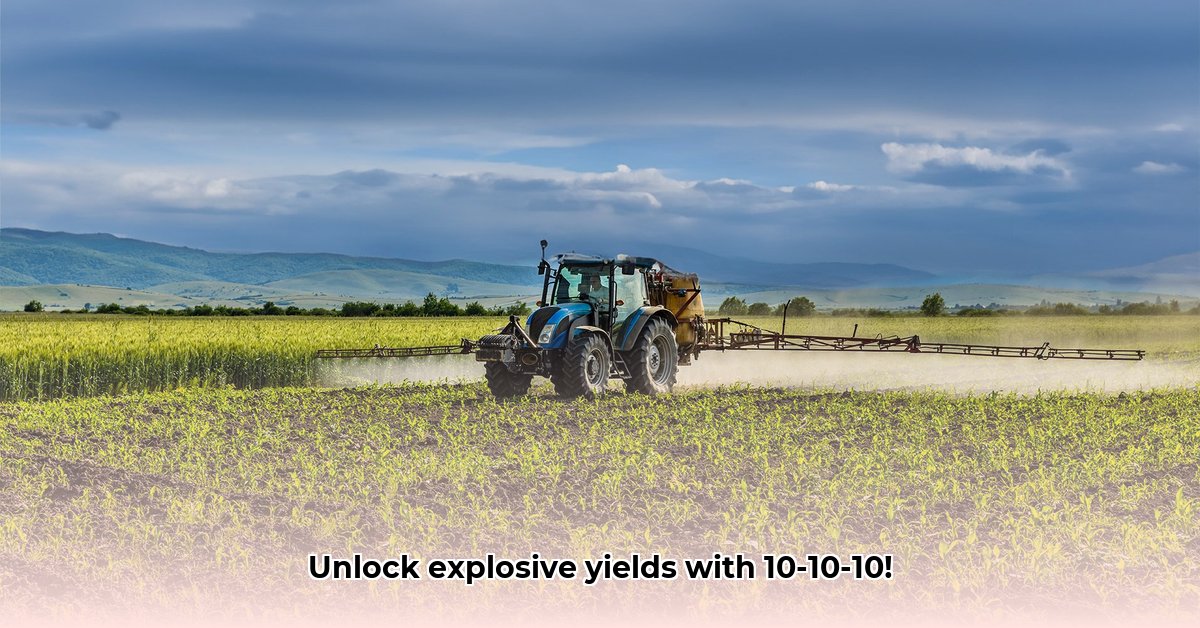
Understanding 10-10-10 Fertilizer and its Role in Sustainable Agriculture
10-10-10 fertilizer, readily available at Tractor Supply and other retailers, is a balanced blend containing equal parts nitrogen (N), phosphorus (P), and potassium (K) by weight. These macronutrients are essential for plant growth: nitrogen promotes vigorous foliage, phosphorus strengthens root systems and flowering, and potassium enhances overall plant health and disease resistance. However, simply applying this fertilizer isn't enough for sustainable agriculture; responsible usage is key to maximizing yields while minimizing environmental impact. Isn't optimizing nutrient use for both plant health and environmental well-being a worthy goal? For more information on similar blends, check out this helpful resource on 10-20-10 fertilizer.
A common misconception is that more fertilizer equals better yields. This couldn't be further from the truth. Over-fertilization leads to wasted resources, increased costs, and potential environmental damage. Conversely, under-fertilization limits plant growth. Therefore, a nuanced understanding of your soil's needs is paramount.
Soil Testing: The Foundation of Sustainable Fertilizer Management
Before applying any fertilizer, a comprehensive soil test is indispensable. This analysis reveals the existing nutrient levels in your soil, guiding you to apply only the necessary supplementary nutrients. Soil testing kits are available at many garden centers or through your local agricultural extension service. These tests provide valuable information on the pH level, along with the concentrations of nitrogen, phosphorus, and potassium. This data-driven approach ensures you're not over-fertilizing, preventing nutrient runoff and maximizing resource efficiency. This precise approach, when contrasted with guesswork, significantly boosts the ROI on your fertilizer investment, doesn't it?
Dr. Emily Carter, Soil Scientist at the University of California, Davis, emphasizes, "Soil testing is not just a good practice; it's the cornerstone of sustainable fertilizer use. It prevents environmental damage while ensuring optimal plant growth."
Precision Application Techniques for Optimal Nutrient Utilization
Precision application maximizes nutrient utilization and minimizes environmental impact. Instead of broadcasting fertilizer across the entire area, focus on targeted application near plant roots. Using a calibrated spreader, appropriate for your garden size, allows for even distribution. For larger fields, GPS-guided application equipment provides even greater accuracy, further optimizing resource use. This targeted approach contrasts sharply with wasteful broadcasting methods, leading to significant improvements in fertilizer efficiency. Studies show that precision application can reduce fertilizer use by up to 30%, significantly reducing environmental impact.
Beyond 10-10-10: Exploring Sustainable Alternatives and Complementary Approaches
While 10-10-10 fertilizer offers a balanced approach, sustainable agriculture encourages exploring diverse methods to enhance soil health. Organic amendments such as compost and well-rotted manure improve soil structure, water retention, and nutrient content naturally. Cover cropping (planting non-harvested crops to enhance soil health) further contributes to building healthy soil.
Integrating these practices with 10-10-10 fertilizer creates a holistic approach, maximizing nutrient availability while fostering a healthy soil ecosystem. Consider this synergy: organic matter improves nutrient uptake, reducing the amount of 10-10-10 needed. This approach increases long-term sustainability and reduces reliance on synthetic fertilizers, wouldn't you agree?
Minimizing Environmental Impact: Best Practices for Sustainable Fertilizer Use
The timing and method of fertilizer application significantly influence the environmental impact. Avoid applying fertilizer immediately before heavy rainfall, as this drastically increases runoff into waterways. Incorporate the fertilizer into the soil rather than surface application to improve nutrient uptake and reduce leaching into groundwater. These simple adjustments can significantly reduce environmental pollution. Improved soil health also enhances water retention, reducing the need for excessive irrigation, which can leach nutrients.
Actionable Steps for Sustainable Fertilizer Use with 10-10-10
Conduct a Soil Test: Determine your soil's nutrient levels to ascertain your fertilizer needs. This foundational step prevents over-application.
Develop a Fertilizer Plan: Based on the soil test, calculate the appropriate amount of 10-10-10 fertilizer required.
Calibrate Your Application Equipment: Ensure accurate fertilizer distribution to avoid waste and ensure even coverage.
Time Application Strategically: Avoid applying fertilizer just before heavy rains, and incorporate it into the soil to maximize uptake and reduce runoff.
Monitor and Adapt: Regularly assess plant health, soil conditions, and adjust your fertilization strategy accordingly. This iterative approach refines your technique over time.
Weighing the Pros and Cons of 10-10-10 Fertilizer
| Pros | Cons |
|---|---|
| Readily available and cost-effective | Potential for nutrient imbalances if not used according to soil test results |
| Provides essential macronutrients | Can contribute to water pollution if not managed properly |
| Relatively simple application methods | May not be the most sustainable long-term solution |
Remember, sustainable agriculture is an evolving process of continuous learning and adaptation. By prioritizing soil health, employing precision application, exploring diverse strategies, and monitoring the outcomes, you can create abundant harvests while minimizing the environmental impact of your agricultural practices.